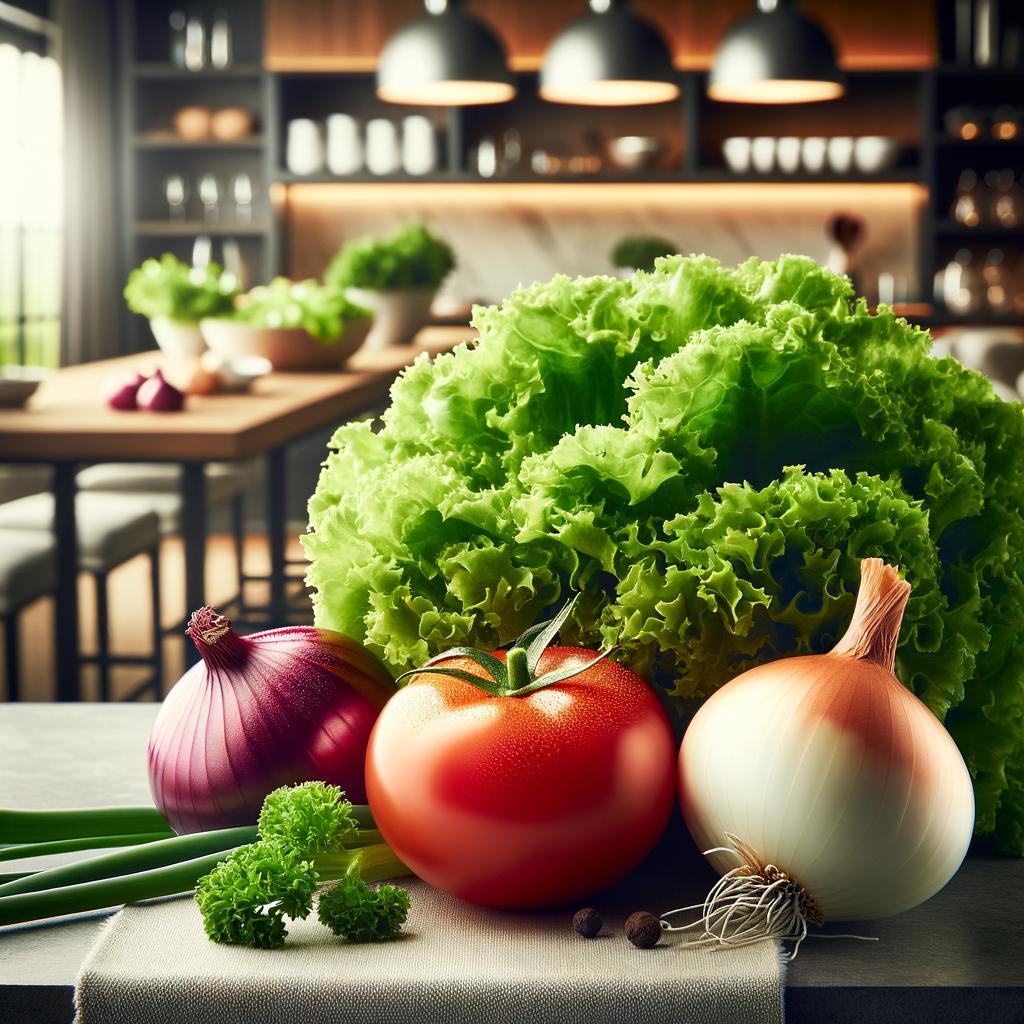Lettuce, Tomato, Onion

Lettuce
Description Lettuce, a leafy green vegetable, is a quintessential ingredient in salads across the globe. Its appearance is a vibrant green, with leaves that are crisp and slightly ruffled. The flavor profile of lettuce is mild and slightly bitter, with a refreshing crunch that adds texture to any dish. The unique characteristic of lettuce is its high water content, making it a hydrating ingredient that is light on the palate.
Primary Uses Lettuce is predominantly used in salads, sandwiches, and wraps, adding a fresh and crunchy element. It is a key component in many cuisines, from the Caesar salad of Italy to the spring rolls of Vietnam. Beyond its culinary uses, lettuce has been used for its medicinal properties, particularly in traditional Chinese medicine, where it's believed to have cooling and calming effects.
History The history of lettuce dates back to ancient Egypt, where it was grown for its seeds and oil. It was later cultivated by the Greeks and Romans, who appreciated it for its health benefits and used it in their meals. The popularity of lettuce spread across Europe during the Middle Ages, and it was one of the first vegetables brought to the Americas by Columbus. Intriguingly, in ancient times, lettuce was also associated with the god of sleep, Hypnos, due to its supposed sedative properties.
Nutritional Information Lettuce is a low-calorie food packed with vitamins A, K, and C. It is also a good source of folate and iron. Its high water and fiber content aids in digestion and hydration. Compared to other leafy greens, lettuce has a lower nutrient density but offers a unique crisp texture and refreshing taste.
Tomato
Description The tomato is a vibrant red fruit, often mistaken for a vegetable, with a smooth, shiny skin and juicy flesh. It has a balanced flavor profile, being both sweet and tangy, with a slight acidity. The uniqueness of tomatoes lies in their lycopene content, a powerful antioxidant that gives tomatoes their red color.
Primary Uses Tomatoes are incredibly versatile in cooking. They can be eaten raw in salads, cooked in sauces, roasted, grilled, or even sun-dried. They are a key component in Italian cuisine, particularly in pasta and pizza sauces. Tomatoes also have non-culinary uses, particularly in skincare, where tomato extract is used for its antioxidant properties.
History Originating in South America, tomatoes were brought to Europe by Spanish explorers in the 16th century. Initially, they were grown as ornamental plants and were thought to be poisonous. However, their culinary potential was soon discovered, and they became a staple in many cuisines. There's a romantic story that the first tomato seeds were brought to Italy by a priest who fell in love with the fruit during a mission in South America.
Nutritional Information Tomatoes are a rich source of vitamins A, C, K, and potassium. They are also known for their high lycopene content, which has been linked to heart health and cancer prevention. Compared to other fruits, tomatoes are lower in sugar and higher in fiber.
Onion
Description The onion, with its layered, spherical structure and papery skin, is a staple in kitchens worldwide. It comes in various colors, including white, yellow, and red. Onions have a pungent, sweet, and spicy flavor that intensifies when cooked. Their unique characteristic is their ability to make people cry when chopped, due to the release of a certain enzyme.
Primary Uses Onions are used in a wide variety of dishes, from stir-fries and soups to roasts and salads. They are a key component in many cuisines, providing a flavor base in many Indian curries, French onion soup, and American burgers. Beyond their culinary uses, onions have been used for their medicinal properties, including their potential to lower blood sugar levels and boost bone health.
History Onions have a rich history dating back to ancient Egypt, where they were worshipped and used in burial rituals. In the Middle Ages, onions were used as currency to pay rent and as gifts. The use and popularity of onions have evolved over time, and they are now a staple in many cuisines. An interesting story is that in the Middle Ages, onions were believed to ward off evil spirits and were hung in homes for protection.
Nutritional Information Onions are a good source of vitamins C and B6, folate, and potassium. They are also rich in antioxidants and contain compounds that have been linked to reduced risk of heart disease and certain cancers. Compared to other vegetables, onions have a higher sugar content, but they are also high in beneficial fibers.

